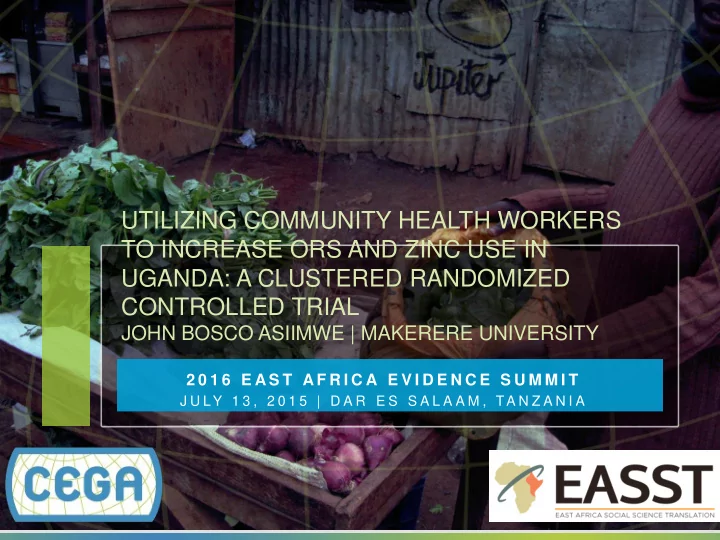

UTILIZING COMMUNITY HEALTH WORKERS TO INCREASE ORS AND ZINC USE IN UGANDA: A CLUSTERED RANDOMIZED CONTROLLED TRIAL JOHN BOSCO ASIIMWE | MAKERERE UNIVERSITY 2 0 1 6 E A S T A F R I C A E V I D E N C E S U M M I T J U LY 1 3 , 2 0 1 5 | D A R E S S A L A A M , TA N Z A N I A
MOTIVATION & POTENTIAL REASONS FOR UNDER- USE OF ORS Motivation • Diarrheal diseases are globally the second leading cause of child mortality under-5 (Liu et al. 2012) • In Uganda, under 5 child mortality is 90 per 1000. Diarrhea accounts for 13% total children’s deaths • Diarrhea is preventable. It is also cheaply treatable through the use of ORS • In Eastern and Central Uganda, the location of the proposed study, under 40% of diarrheal cases are treated with ORS (UDHS 2011). Potential reasons for under-use • Price (addressed by our study) • Distance/Convenience (addressed by our study) • Cultural/Belief/Preference barriers (not addressed by our study)
OVERVIEW OF THE INTERVENTION Group 1 – Control: Maintain Status Quo Group 2 – Household Visit/info + Free Distribution + Pre- Emptive Delivery/Home Storage: Addresses Price and Distance Group 3 – Household Visit/Info + Cost Sharing/Selling + Pre- Emptive Delivery/Home Storage : Addresses Distance alone Group 4 – Household Visit/Info + Free Distribution Upon Retrieval From the CHP’s household: Addresses Price alone Group 2-Group 3= Impact of free distribution vs. cost sharing Group 2-Group 4= Impact of increased convenience Group 2-Group 1= impact of free distribution and convenience • )
CHP/CHW APPROACH & DESIGN • Administered by BRAC, a large Bangladesh-based NGO. In about 3,000 villages in over 70 districts in Uganda • Provide health care services referrals, and health education during household visits • Not trained medical health workers • Goal of program is to increase access to essential health products DESIGN • Clustered randomized controlled trial (Village Level = CHP Level) • 120 Villages (30 per arm) with sample of 2,400 Cases of Diarrhea • 20 cases per village (20-25% with a case in last 4-weeks) • Detectable effect of 40% to 51% (power of .8)
MAIN OUTCOMES AND DISCUSSION OF HOW THEY ARE COLLECTED Self Report 1. ORS Use (primary outcome) 2. Zinc Use 3. Antibiotic Use 4. Time to ORS use 5. Time to Zinc use Observation Empty packets will be observed and used to identify use. Incentives will provided to keep empty packets (Group 2 only)
PRELIMINARY RESULTS: FORMATIVE WORK & PILOT
POLICY IMPLICATIONS: EVIDENCE ON PROGRAM ELECTIVENESS Implications For BRAC • If successful BRAC will scale-up across Uganda • Simple and cheap intervention • CHPs already make household visits Implications For Uganda Government • Government funds Village Health Team (VHT) program • VHTs are very similar to CHPs • Volunteer community members • Door-to-door visits
Recommend
More recommend